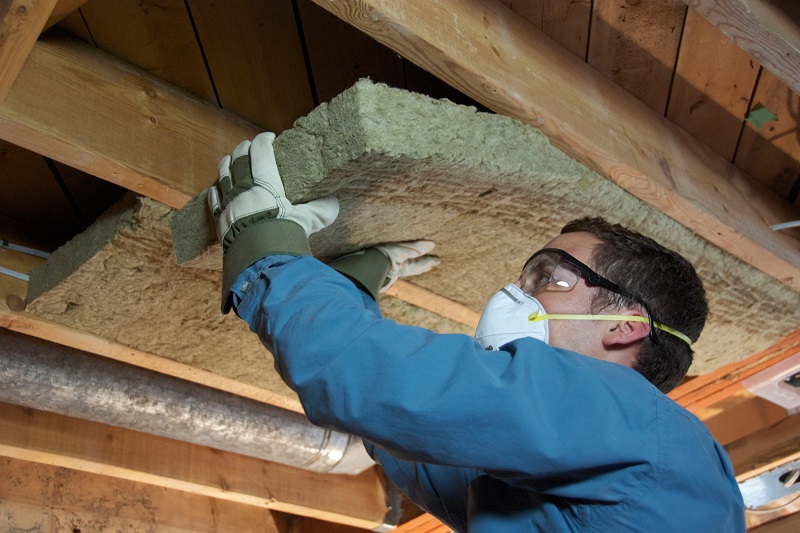Fire insulation in buildings

|
Contents |
[edit] Introduction
Fire occurs as a result of a series of very rapid chemical reactions between a fuel and oxygen that releases heat and light. For combustion to occur, oxygen, heat and a fuel source must all be present; this is the ‘fire triangle’. Flames are the visible manifestation of combustion.
Fire insulation (or more usually fire-rated or fire-resistant insulation) is a term that covers insulation materials which have insulative properties but are also non-combustible or have limited combustibility. As passive fire protection elements, they do not need to be activated to provide fire resistance and hence can help prevent the spread of flame between spaces and components within and between buildings.
By slowing the spread of flame, such materials can protect structure and property and allow people valuable time to escape.
A typical example is stone wool insulation which can be non-combustible. Other types of insulation that may provide fire resistance include mineral wool, fibreglass and cellulose-based wool insulation. Sheep’s wool is regarded as a sustainable insulation solution but must first be treated to make it more fire resistant. Some of these products are available in blankets (supplied in rolls) and/or rigid slabs.
For further information, see Insulation
Fire-rated insulation in a building can be used in a number of places, including in:
- Cladding;
- Floors and ceilings;
- Roofs;
- On structural steel;
- Cavity barriers and firestopping;
- HVAC applications.
In addition to its fire-resisting properties, the insulation used in the above applications may also provide acoustic and thermal insulation.
[edit] Regulations and standards
Part B of the Building Regulations sets out the fire performance requirements of buildings. For a fire-rated insulation to be used in a building it must pass certain British Standard (BS) tests: products are classified according to how they perform in the tests, enabling specifiers and contractors to choose the best fire-rated insulation for a given application. The tests are:
- BS 476-1: Fire tests on building materials and structures, and
- BS EN 13501-1:2018: Fire classification of construction products and building elements (Classification using test data from reaction to fire tests). This has become the construction industry’s main ‘go to’ standard for fire insulation. It provides the reaction to fire classification procedure for all construction products, including products incorporated within building elements with the exception of power, control and communication cables which are covered by EN 13501-6. Products are considered in relation to their end-use application.
BS EN 13501-1:2018 has three fire performance ratings which cover:
- Combustibility (divided into seven classifications from A1 (non-combustible), A2 (limited combustibility) right through to F (easily flammable);
- Smoke emission during combustion (s1 (highest), s2 or s3 (lowest)), and
- The level of production of flaming droplets/particles during combustion (d0 (highest), d1 or d2 (lowest)).
[edit] Grenfell Tower
The 2017 Grenfell Tower Fire is thought to have been exacerbated by ACM cladding which incorporated a Celotex RS5000 PIR insulation. As a result, In December 2018 changes to approved document 7 came into force banning combustible materials in the cladding for buildings over 18m in height.
For more infomation see: Grenfell Tower fire.
[edit] Related articles on Designing Buildings Wiki
- Acoustic insulation
- Acoustic insulation market
- Advice for External Wall Insulation (EWI) systems with a render or brick-slip finish
- Aerogel insulation for buildings
- BR 135 Fire Performance of external thermal insulation for walls of multi-storey buildings
- BREEAM Insulation
- Cavity wall insulation
- Celotex RS5000 PIR insulation
- Designing out unintended consequences when applying solid wall insulation FB 79
- Domestic floors: Part 1: Construction, insulation and damp proofing
- External wall insulation
- Floor insulation
- Grenfell Tower fire
- Icynene spray foam insulation
- Insulation for ground floors
- Loft insulation ruling
- PA ratio for insulation
- Phenolic foam insulation
- Reducing thermal bridging at junctions when designing and installing solid wall insulation FB 61
- Roof insulation
- Solid wall insulation
- Solid Wall Insulation: Unlocking demand and driving up standards
- Sound insulation in buildings
- Sound insulation in dwellings Part 2: New-build (GG 83-2)
- Sound insulation in dwellings: Part 1: An introduction (GG 83-1)
- Sound insulation in dwellings: Part 3: Material change of use (conversions) (GG 83-3)
- Specifying insulation for inverted roofs
- Ten facts about Expanded Polystyrene (EPS) insulation to help specifiers
- Thermal insulation for buildings
- Transparent insulation
- Types of insulation
- Understanding Insulation and the Part It Plays in Building Regulations
- Wall insulation and moisture risk
- Wood and insulation
Featured articles and news
Infrastructure that connect the physical and digital domains.
Harnessing robotics and AI in challenging environments
The key to nuclear decommissioning and fusion engineering.
BSRIA announces Lisa Ashworth as new CEO
Tasked with furthering BSRIA’s impressive growth ambitions.
Public buildings get half a million energy efficiency boost
£557 million to switch to cleaner heating and save on energy.
CIOB launches pre-election manifesto
Outlining potential future policies for the next government.
Grenfell Tower Inquiry announcement
Phase 2 hearings come to a close and the final report due in September.
Progress from Parts L, F and O: A whitepaper, one year on.
A replicated study to understand the opinion of practitioners.
ECA announces new president 2024
Electrical engineer and business leader Stuart Smith.
A distinct type of countryside that should be celebrated.
Should Part O be extended to existing buildings?
EAC brands heatwave adaptation a missed opportunity.
Definition of Statutory in workplace and facilities management
Established by IWFM, BESA, CIBSE and BSRIA.
Tackling the transition from traditional heating systems
59% lack the necessary information and confidence to switch.
The general election and the construction industry
As PM, Rishi Sunak announces July 4 date for an election.
Eco apprenticeships continue help grow green workforce
A year after being recognised at the King's coronation.
Permitted development rights for agricultural buildings
The changes coming into effect as of May 21, 2024.





















